Study on the Concentration of Top Air Pollutants in Xuzhou City in Winter 2020 Based on the WRF-Chem and ADMS-Urban Models
Abstract
:1. Introduction
2. Data and Methods
2.1. Study Area
2.2. WRF-Chem Model
2.3. ADMS-Urban Model
2.4. AQI Calculation
2.5. Model Validation and Evaluation
3. Results and Discussion
3.1. Simulation of PM Concentration
3.2. Simulation of Meteorology
3.3. Simulations on Heavily Polluted Days
3.3.1. WRF-Chem Simulations
3.3.2. ADMS-Urban Simulations
4. Discussion
5. Conclusions
Author Contributions
Funding
Institutional Review Board Statement
Informed Consent Statement
Data Availability Statement
Acknowledgments
Conflicts of Interest
References
- Tian, Y.; He, C.; Yang, L.; Yi, J.H.; Ke, B.Q.; Mu, H.; Tu, P.Y.; Ye, Z.X.; Hong, S. Spatiotemporal Dynamic Correlation Characteristics and Driving Factors of Major Air Pollutant Emissions in China. Atmosphere 2023, 14, 130. [Google Scholar] [CrossRef]
- Li, X.J.; Hussain, S.A.; Sobri, S.; Said, M. Overviewing the air quality models on air pollution in Sichuan Basin, China. Chemosphere 2021, 271, 129502. [Google Scholar] [CrossRef] [PubMed]
- Jia, Z.X.; Doherty, R.M.; Ordóñez, C.; Li, C.F.; Wild, O.; Jain, S.; Tang, X. The impact of large-scale circulation on daily fine particulate matter (PM2.5) over major populated regions of China in winter. Atmos. Chem. Phys. 2022, 22, 6471–6487. [Google Scholar] [CrossRef]
- Geng, G.N.; Zheng, Y.X.; Zhang, Q.; Xue, T.; Zhao, H.Y.; Tong, D.; Zheng, B.; Li, M.; Liu, F.; Hong, C.P.; et al. Drivers of PM2.5 air pollution deaths in China 2002–2017. Nat. Geosci. 2021, 14, 645. [Google Scholar] [CrossRef]
- Yang, Y.; Ren, L.L.; Wu, M.X.; Wang, H.L.; Song, F.F.; Leung, L.R.; Hao, X.; Li, J.D.; Chen, L.; Li, H.M.; et al. Abrupt emissions reductions during COVID-19 contributed to record summer rainfall in China. Nat. Commun. 2022, 13, 959. [Google Scholar] [CrossRef] [PubMed]
- Zou, J.A.; Cao, Q.M.; Gao, W.K.; Liu, Z.R.; Wang, H.L.; Hu, B.; Wang, Y.S. The effects of number and mass concentration of aerosol components on scattering coefficients in Xianghe, southeast of Beijing, China-A case study. Atmos. Environ. 2022, 272, 118938. [Google Scholar] [CrossRef]
- Sokhi, R.S.; Moussiopoulos, N.; Baklanov, A.; Bartzis, J.; Coll, I.; Finardi, S.; Friedrich, R.; Geels, C.; Grönholm, T.; Halenka, T.; et al. Advances in air quality research—Current and emerging challenges. Atmos. Chem. Phys. 2022, 22, 4615–4703. [Google Scholar] [CrossRef]
- Wang, X.Y.; Zhang, R.H. Effects of atmospheric circulations on the interannual variation in PM2.5 concentrations over the Beijing-Tianjin-Hebei region in 2013–2018. Atmos. Chem. Phys. 2020, 20, 7667–7682. [Google Scholar] [CrossRef]
- Tang, M.F.; Wu, X.; Agrawal, P.; Pongpaichet, S.; Jain, R. Integration of Diverse Data Sources for Spatial PM2.5 Data Interpolation. IEEE Trans. Multimed. 2017, 19, 408–417. [Google Scholar] [CrossRef]
- Kukkonen, J.; Olsson, T.; Schultz, D.M.; Baklanov, A.; Klein, T.; Miranda, A.I.; Monteiro, A.; Hirtl, M.; Tarvainen, V.; Boy, M.; et al. A review of operational, regional-scale, chemical weather forecasting models in Europe. Atmos. Chem. Phys. 2012, 12, 1–87. [Google Scholar] [CrossRef]
- Bohnenstengel, S.I.; Belcher, S.E.; Aiken, A.; Allan, J.D.; Allen, G.; Bacak, A.; Bannan, T.J.; Barlow, J.F.; Beddows, D.; Bloss, W.J.; et al. Meteorology, Air Quality, and Health in London: The ClearfLo Project. Bull. Am. Meteorol. Soc. 2015, 96, 779–804. [Google Scholar] [CrossRef]
- Yang, X.Y.; Wu, K.; Wang, H.L.; Liu, Y.M.; Gu, S.; Lu, Y.Q.; Zhang, X.L.; Hu, Y.S.; Ou, Y.H.; Wang, S.G.; et al. Summertime ozone pollution in Sichuan Basin, China: Meteorological conditions, sources and process analysis. Atmos. Environ. 2020, 226, 117392. [Google Scholar] [CrossRef]
- Shukla, K.K.; Attada, R.; Khan, A.W.; Kumar, P. Evaluation of extreme dust storm over the northwest Indo-Gangetic plain using WRF-Chem model. Nat. Hazards 2022, 110, 1887–1910. [Google Scholar] [CrossRef]
- Qiao, Z.; Cui, S.C.; Pei, C.L.; Ye, Z.; Wu, X.Q.; Lei, L.; Luo, T.; Zhang, Z.H.; Li, X.B.; Zhu, W.Y. Regional Predictions of Air Pollution in Guangzhou: Preliminary Results and Multi-Model Cross-Validations. Atmosphere 2022, 13, 1527. [Google Scholar] [CrossRef]
- Shahid, M.Z.; Chishtie, F.; Bilal, M.; Shahid, I. WRF-Chem Simulation for Modeling Seasonal Variations and Distributions of Aerosol Pollutants over the Middle East. Remote Sens. 2021, 13, 2112. [Google Scholar] [CrossRef]
- Do, T.; Ngo, X.T.; Pham, V.H.; Vuong, N.L.; Le, H.A.; Pham, C.T.; Bui, Q.H.; Nguyen, T. Application of WRF-Chem to simulate air quality over Northern Vietnam. Environ. Sci. Pollut. Res. 2021, 28, 12067–12081. [Google Scholar] [CrossRef]
- Rostkier-Edelstein, D.; Kunin, P.; Sheu, R.S.; Gelman, A.; Yunker, A.; Roux, G.; Pietrkowski, A.; Zhang, Y.X. Evaluation of WRF-Chem-RTFDDA dust forecasts over the MENA region using in-situ and remote-sensing observations. Front. Environ. Sci. 2022, 10, 1747. [Google Scholar] [CrossRef]
- Georgiou, G.K.; Christoudias, T.; Proestos, Y.; Kushta, J.; Pikridas, M.; Sciare, J.; Savvides, C.; Lelieveld, J. Evaluation of WRF-Chem model (v3.9.1.1) real-time air quality forecasts over the Eastern Mediterranean. Geosci. Model Dev. 2022, 15, 4129–4146. [Google Scholar] [CrossRef]
- Owen, B.; Edmunds, H.A.; Carruthers, D.J.; Singles, R.J. Prediction of total oxides of nitrogen and nitrogen dioxide concentrations in a large urban area using a new generation urban scale dispersion model with integral chemistry model. Atmos. Environ. 2000, 34, 397–406. [Google Scholar] [CrossRef]
- He, B.; Heal, M.R.; Humstad, K.H.; Yan, L.; Zhang, Q.; Reis, S. A hybrid model approach for estimating health burden from NO2 in megacities in China: A case study in Guangzhou. Environ. Res. Lett. 2019, 14, 124019. [Google Scholar] [CrossRef]
- Munir, S.; Habeebullah, T.M. Vehicular emissions on main roads in Makkah, Saudi Arabiaa dispersion modelling study. Arab. J. Geosci. 2018, 11, 531. [Google Scholar] [CrossRef]
- Dimitrova, R.; Velizarova, M. Assessment of the Contribution of Different Particulate Matter Sources on Pollution in Sofia City. Atmosphere 2021, 12, 423. [Google Scholar] [CrossRef]
- Biggart, M.; Stocker, J.; Doherty, R.M.; Wild, O.; Hollaway, M.; Carruthers, D.; Li, J.; Zhang, Q.; Wu, R.L.; Kotthaus, S.; et al. Street-scale air quality modelling for Beijing during a winter 2016 measurement campaign. Atmos. Chem. Phys. 2020, 20, 2755–2780. [Google Scholar] [CrossRef]
- Ukhov, A.; Mostamandi, S.; Da Silva, A.; Flemming, J.; Alshehri, Y.; Shevchenko, I.; Stenchikov, G. Assessment of natural and anthropogenic aerosol air pollution in the Middle East using MERRA-2, CAMS data assimilation products, and high-resolution WRF-Chem model simulations. Atmos. Chem. Phys. 2020, 20, 9281–9310. [Google Scholar] [CrossRef]
- Zhong, J.; Hood, C.; Johnson, K.; Stocker, J.; Handley, J.; Wolstencroft, M.; Mazzeo, A.; Cai, X.M.; Bloss, W.J. Using Task Farming to Optimise a Street-Scale Resolution Air Quality Model of the West Midlands (UK). Atmosphere 2021, 12, 983. [Google Scholar] [CrossRef]
- Westmoreland, E.J.; Carslaw, N.; Carslaw, D.C.; Gillah, A.; Bates, E. Analysis of air quality within a street canyon using statistical and dispersion modelling techniques. Atmos. Environ. 2007, 41, 9195–9205. [Google Scholar] [CrossRef]
- Zhang, Y.X.; Olsen, S.C.; Dubey, M.K. WRF/Chem simulated springtime impact of rising Asian emissions on air quality over the US. Atmos. Environ. 2010, 44, 2799–2812. [Google Scholar] [CrossRef]
- Grell, G.A.; Peckham, S.E.; Schmitz, R.; Mckeen, S.A.; Frost, G.; Skamarock, W.C.; Eder, B. Fully coupled “online” chemistry within the WRF model. Atmos. Environ. 2005, 39, 6957–6975. [Google Scholar] [CrossRef]
- Chapman, E.G.; Gustafson, W.I.; Easter, R.C.; Barnard, J.C.; Ghan, S.J.; Pekour, M.S.; Fast, J.D. Coupling aerosol-cloud-radiative processes in the WRF-Chem model: Investigating the radiative impact of elevated point sources. Atmos. Chem. Phys. 2009, 9, 945–964. [Google Scholar] [CrossRef]
- Stockwell, W.R.; Middleton, P.; Chang, J.S.; Tang, X. The second generation regional acid deposition model chemical mechanism for regional air quality modeling. J. Geophys. Res.-Atmos. 1990, 95, 16343–16367. [Google Scholar] [CrossRef]
- Seefeld, W.R.S.K. A new mechanism for regional atmospheric chemistry modeling. J. Geophys. Res.-Atmos. 1997, 102, 25847–25879. [Google Scholar]
- Zaveri, R.A.; Peters, L.K. A new lumped structure photochemical mechanism for large-scale applications. J. Geophys. Res.-Atmos. 1999, 104, 30387–30415. [Google Scholar] [CrossRef]
- Gery, M.W.; Whitten, G.Z.; Killus, J.P.; Dodge, M.C. A photochemical kinetics mechanism for urban and regional scale computer modeling. J. Geophys. Res. 1989, 94, 12925–12956. [Google Scholar] [CrossRef]
- Yarwood, G.; Rao, S.; Yocke, M.; Whitten, G. Updates to the Carbon Bond Chemical Mechanism: CB05 Final Report to the US EPA; EPA: Washington, DC, USA, 2005.
- Carter. Implementation of the SAPRC-99 Chemical Mechanism into the Models-3 Framework; Carter: Atlanta, GA, USA, 2000. [Google Scholar]
- Ij, A.; Memmesheimer, M.; Ebel, A.; Fs, B.; Shankar, U.; Hass, H. Modal aerosol dynamics model for Europe: Development and first applications. Atmos. Environ. 1998, 32, 2981–2999. [Google Scholar]
- Schell, B.; Ackermann, I.J.; Hass, H.; Binkowski, F.S.; Ebel, A. Modeling the formation of secondary organic aerosol within a comprehensive air quality model system. J. Geophys. Res.-Atmos. 2001, 106, 28275–28293. [Google Scholar] [CrossRef]
- Ahmadov, R.; Mckeen, S.A.; Robinson, A.L.; Bahreini, R.; Middlebrook, A.M.; Gouw, J.A.D.; Meagher, J.; Hsie, E.Y.; Edgerton, E.; Shaw, S. A volatility basis set model for summertime secondary organic aerosols over the eastern United States in 2006. J. Geophys. Res.-Atmos. 2012, 117, 6301. [Google Scholar] [CrossRef]
- Liu, X.; Easter, R.C.; Ghan, S.J.; Zaveri, R.; Rasch, P.; Shi, X.; Lamarque, J.F.; Gettelman, A.; Morrison, H.; Vitt, F.; et al. Toward a minimal representation of aerosols in climate models: Description and evaluation in the Community Atmosphere Model CAM5. Geosci. Model Dev. 2012, 5, 709–739. [Google Scholar] [CrossRef]
- Zaveri, R.A.; Easter, R.C.; Fast, J.D.; Peters, L.K. Model for Simulating Aerosol Interactions and Chemistry (MOSAIC). J. Geophys. Res.-Atmos. 2008, 113, D13204. [Google Scholar] [CrossRef]
- Chin, M.; Ginoux, P.; Kinne, S.; Torres, O.; Holben, B.N.; Duncan, B.N.; Martin, R.V.; Logan, J.A.; Higurashi, A.; Nakajima, T. Tropospheric aerosol optical thickness from the GOCART model and comparisons with satellite and Sun photometer measurements. J. Atmos. Sci. 2002, 59, 461–483. [Google Scholar] [CrossRef]
- Chen, S.H.; Sun, W.Y. A one-dimensional time dependent cloud model. J. Meteorol. Soc. Jpn. 2002, 80, 99–118. [Google Scholar] [CrossRef]
- Grell, G.A.; Dévényi, D. A generalized approach to parameterizing convection combining ensemble and data assimilation techniques. Geophys. Res. Lett. 2002, 29, 38-1–38-4. [Google Scholar] [CrossRef]
- Ej, M.; Pd, B.; Mj, I.; Sa, C.; Sj, T. Radiative transfer for inhomogeneous atmospheres—RRTM, a validated correlated-k model for the longwave. J. Geophys. Res. Atmos. 1997, 102, 16663–16682. [Google Scholar]
- Matsui, T.; Zhang, S.Q.; Lang, S.E.; Tao, W.K.; Ichoku, C.; Peters-Lidard, C.D. Impact of radiation frequency, precipitation radiative forcing, and radiation column aggregation on convection-permitting West African monsoon simulations. Clim. Dynam. 2020, 55, 193–213. [Google Scholar] [CrossRef]
- Jiménez, P.A.; Dudhia, J.; González-Rouco, J.F.; Navarro, J.; Montávez, J.P.; García-Bustamante, E. A Revised Scheme for the WRF Surface Layer Formulation. Mon. Weather Rev. 2012, 140, 898–918. [Google Scholar] [CrossRef]
- Weston, M.; Chaouch, N.; Valappil, V.; Temimi, M.; Ek, M.; Zheng, W.Z. Assessment of the Sensitivity to the Thermal Roughness Length in Noah and Noah-MP Land Surface Model Using WRF in an Arid Region. Pure Appl. Geophys. 2019, 176, 2121–2137. [Google Scholar] [CrossRef]
- Hong, S.Y.; Noh, Y.; Dudhia, J. A new vertical diffusion package with an explicit treatment of entrainment processes. Mon. Weather Rev. 2006, 134, 2318–2341. [Google Scholar] [CrossRef]
- Wild, O.; Zhu, X.; Prather, M.J. Fast-J: Accurate Simulation of In- and Below-Cloud Photolysis in Tropospheric Chemical Models. J. Atmos. Chem. 2000, 37, 245–282. [Google Scholar] [CrossRef]
- National Centers For Environmental Prediction; National Weather Service; NOAA; U.S. Department of Commerce. NCEP FNL Operational Model Global Tropospheric Analyses, Continuing from July 1999; Research Data Archive at the National Center for Atmospheric Research, Computational and Information Systems Laboratory: Boulder, CO, USA, 2000.
- Lamarque, J.F.; Emmons, L.K.; Hess, P.G.; Kinnison, D.E.; Tilmes, S.; Vitt, F.; Heald, C.L.; Holland, E.A.; Lauritzen, P.H.; Neu, J.; et al. CAM-chem: Description and evaluation of interactive atmospheric chemistry in the Community Earth System Model. Geosci. Model Dev. 2012, 5, 369–411. [Google Scholar] [CrossRef]
- Guenther, A.B.; Jiang, X.; Heald, C.L.; Sakulyanontvittaya, T.; Duhl, T.; Emmons, L.K.; Wang, X. The Model of Emissions of Gases and Aerosols from Nature version 2.1 (MEGAN2.1): An extended and updated framework for modeling biogenic emissions. Geosci. Model Dev. 2012, 5, 1471–1492. [Google Scholar] [CrossRef]
- Li, M.; Liu, H.; Geng, G.N.; Hong, C.P.; Liu, F.; Song, Y.; Tong, D.; Zheng, B.; Cui, H.Y.; Man, H.Y.; et al. Anthropogenic emission inventories in China: A review. Natl. Sci. Rev. 2017, 4, 834–866. [Google Scholar] [CrossRef]
- Zheng, B.; Tong, D.; Li, M.; Liu, F.; Hong, C.P.; Geng, G.N.; Li, H.Y.; Li, X.; Peng, L.Q.; Qi, J.; et al. Trends in China’s anthropogenic emissions since 2010 as the consequence of clean air actions. Atmos. Chem. Phys. 2018, 18, 14095–14111. [Google Scholar] [CrossRef]
- Mchugh, C.A.; Carruthers, D.J.; Edmunds, H.A. ADMS-Urban: An air quality management system for traffic, domestic and industrial pollution. Int. J. Environ. Pollut. 1997, 8, 666–674. [Google Scholar]
- Stocker, J.; Hood, C.; Carruthers, D.; Mchugh, C. ADMS-Urban: Developments in modelling dispersion from the city scale to the local scale. Int. J. Environ. Pollut. 2012, 50, 308–316. [Google Scholar] [CrossRef]
- Righi, S.; Lucialli, P.; Pollini, E. Statistical and diagnostic evaluation of the ADMS-Urban model compared with an urban air quality monitoring network. Atmos. Environ. 2009, 43, 3850–3857. [Google Scholar] [CrossRef]
- Jiang, Z.X.; Gao, Y.C.; Cao, H.X.; Diao, W.X.; Yao, X.; Yuan, C.C.; Fan, Y.Y.; Chen, Y. Characteristics of ambient air quality and its air quality index (AQI) model in Shanghai, China. Sci. Total Environ. 2023, 896, 165284. [Google Scholar] [CrossRef] [PubMed]
- Falzone, C.; Romain, A.C. Establishing an Air Quality Index Based on Proxy Data for Urban Planning Part 1: Methodological Developments and Preliminary Tests. Atmosphere 2022, 13, 1470. [Google Scholar] [CrossRef]
- Li, Y.P.; Tang, Y.; Fan, Z.Y.; Zhou, H.; Yang, Z.Z. Assessment and comparison of three different air quality indices in China. Environ. Eng. Res. 2018, 23, 21–27. [Google Scholar] [CrossRef]
- Chen, W.; Wang, F.S.; Xiao, G.F.; Wu, K.; Zhang, S.X. Air Quality of Beijing and Impacts of the New Ambient Air Quality Standard. Atmosphere 2015, 6, 1243–1258. [Google Scholar] [CrossRef]
- Jin, W. Study on PM2.5 Pollution over Xuzhou Using WRF-Chem. Master’s Thesis, China University of Mining and Technology, Xuzhou, China, 2017. [Google Scholar]
- Wen, J.K.; Wang, T.J.; Ma, G.H.; Sheng, X.Y.; Wang, Y.Z.; Lu, X.B.; Xiang, H.J.; Wu, D.L.; Li, G.M. Comparison between WRF-Chem and ADMS in the refined simulation of urban scale air pollution. Acta Sci. Circumstantiae 2022, 42, 276–292. [Google Scholar] [CrossRef]
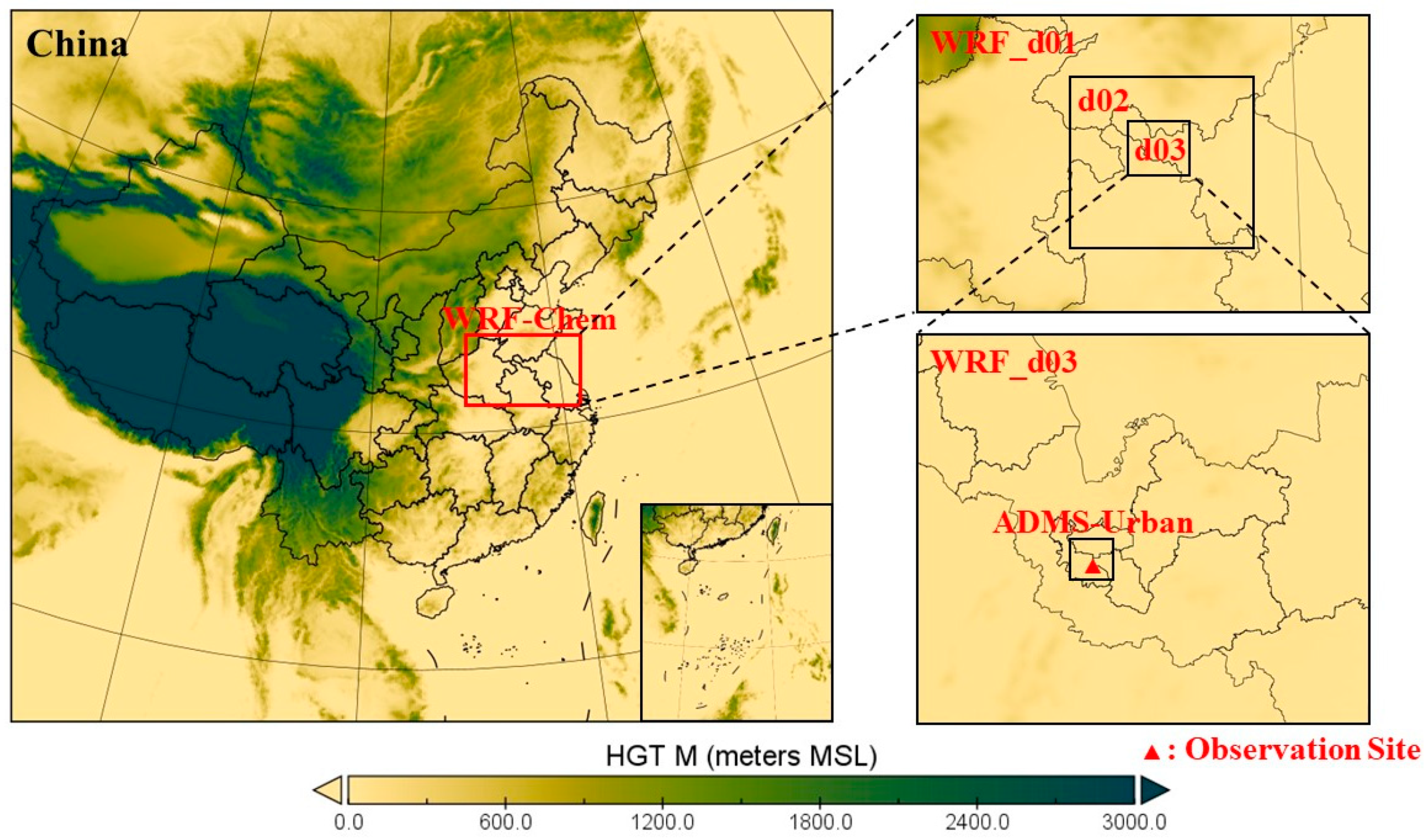
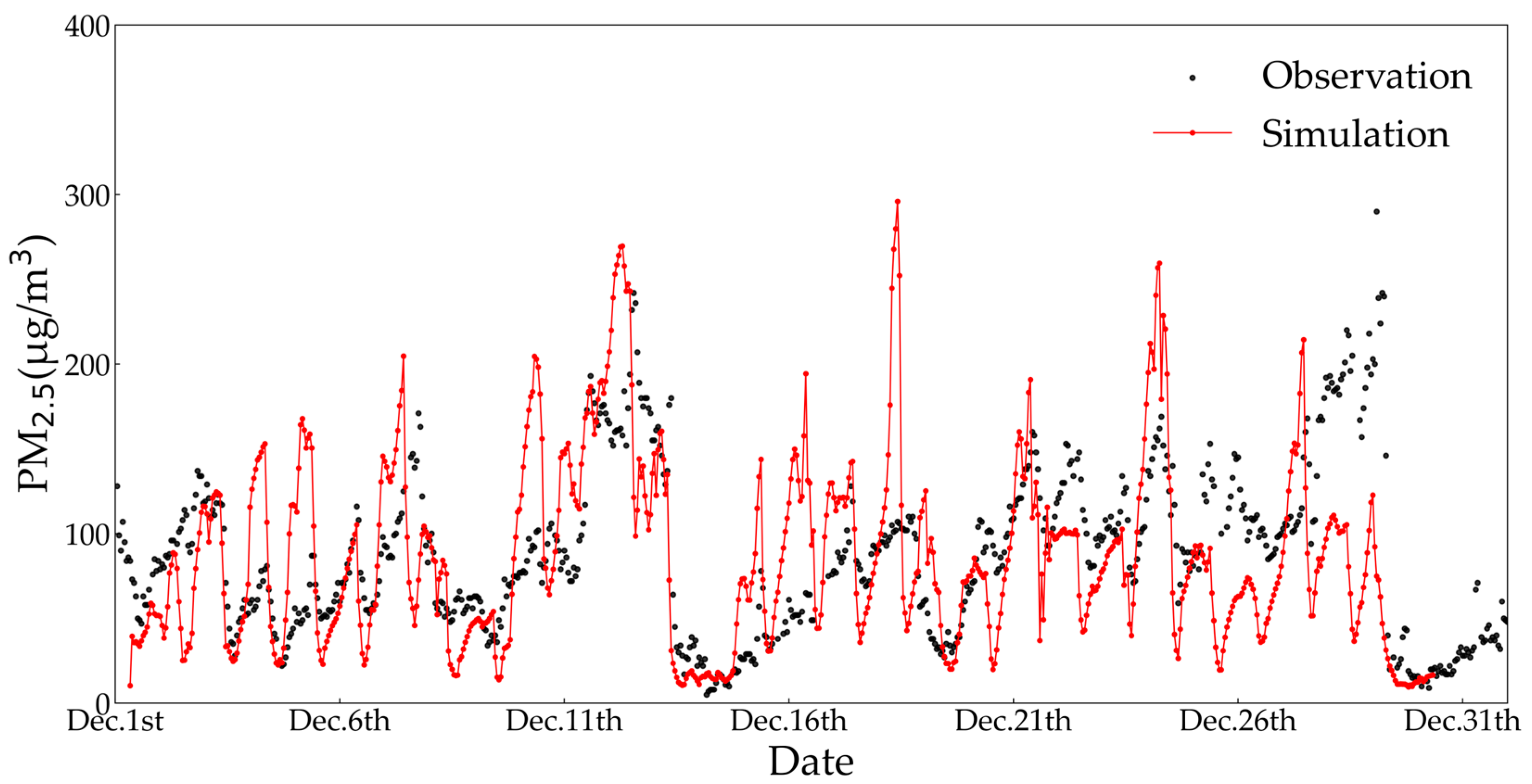
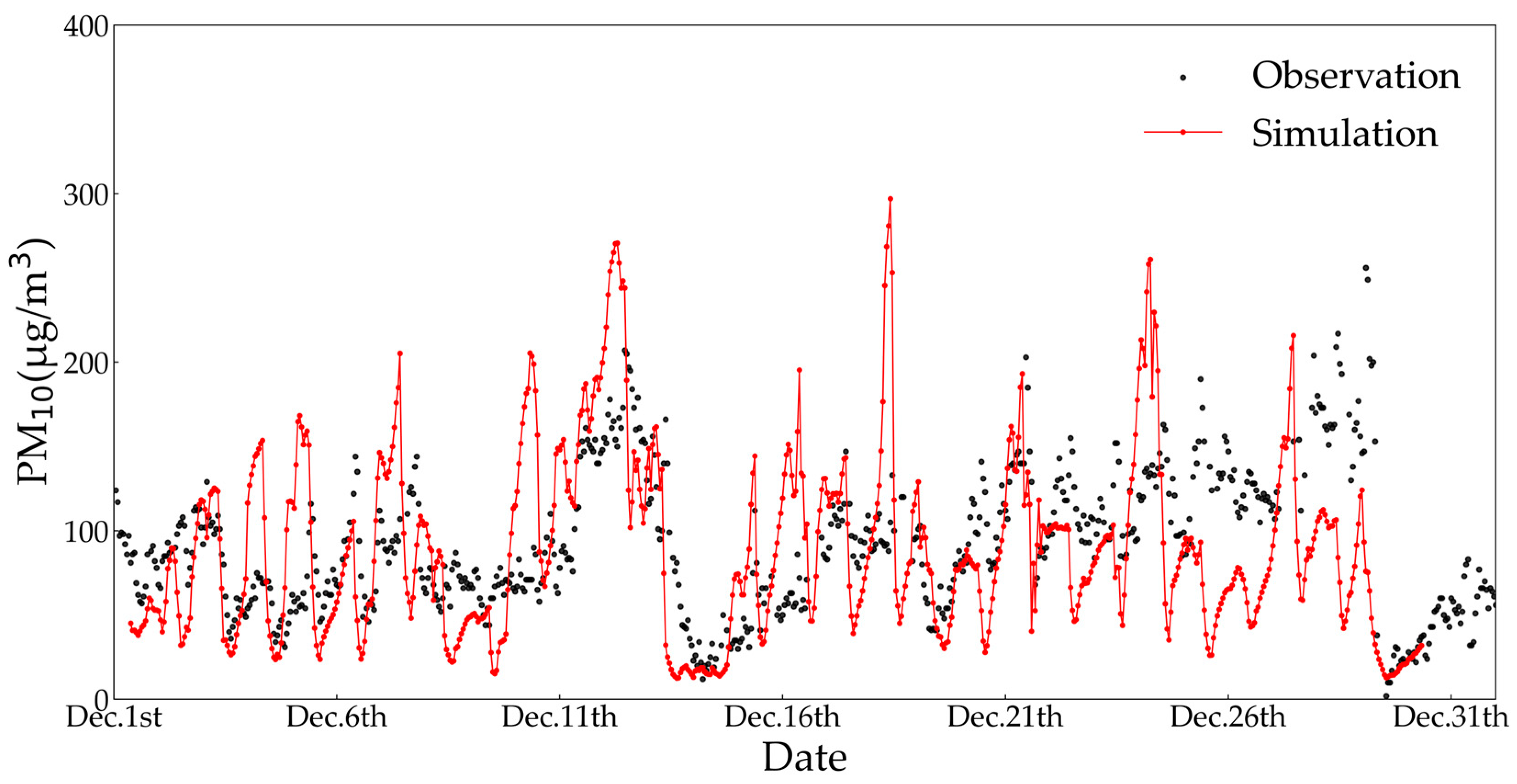


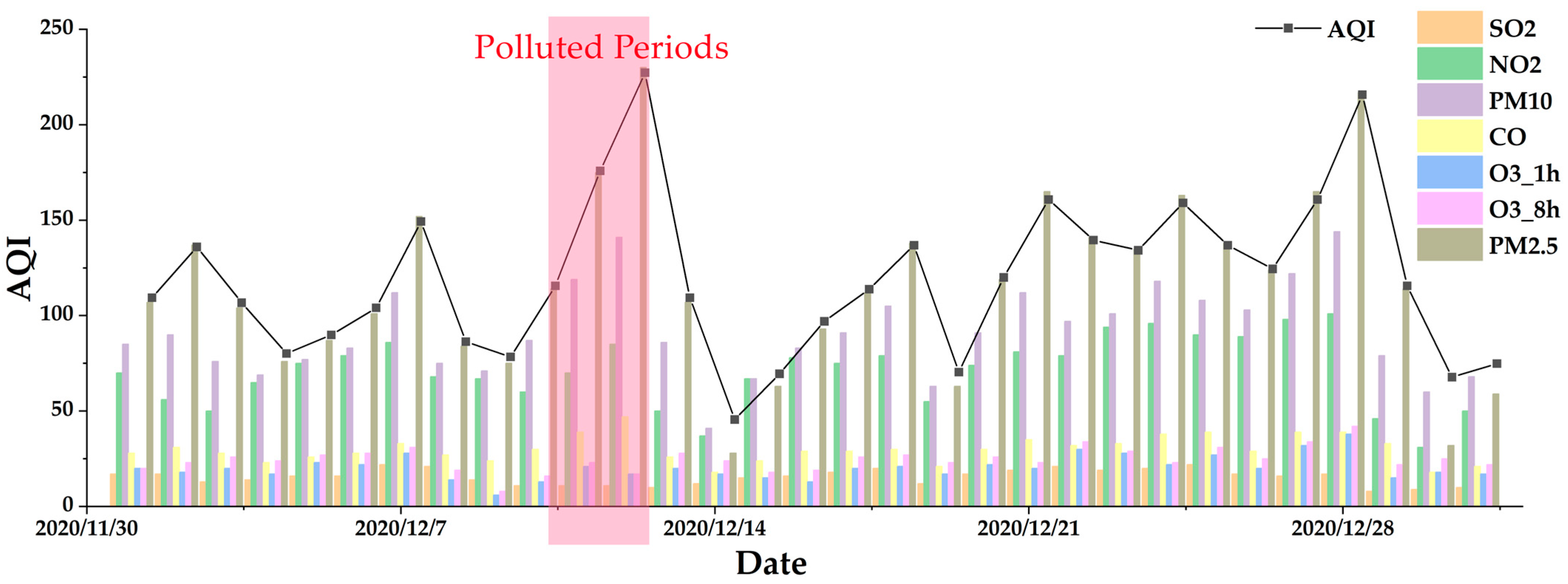

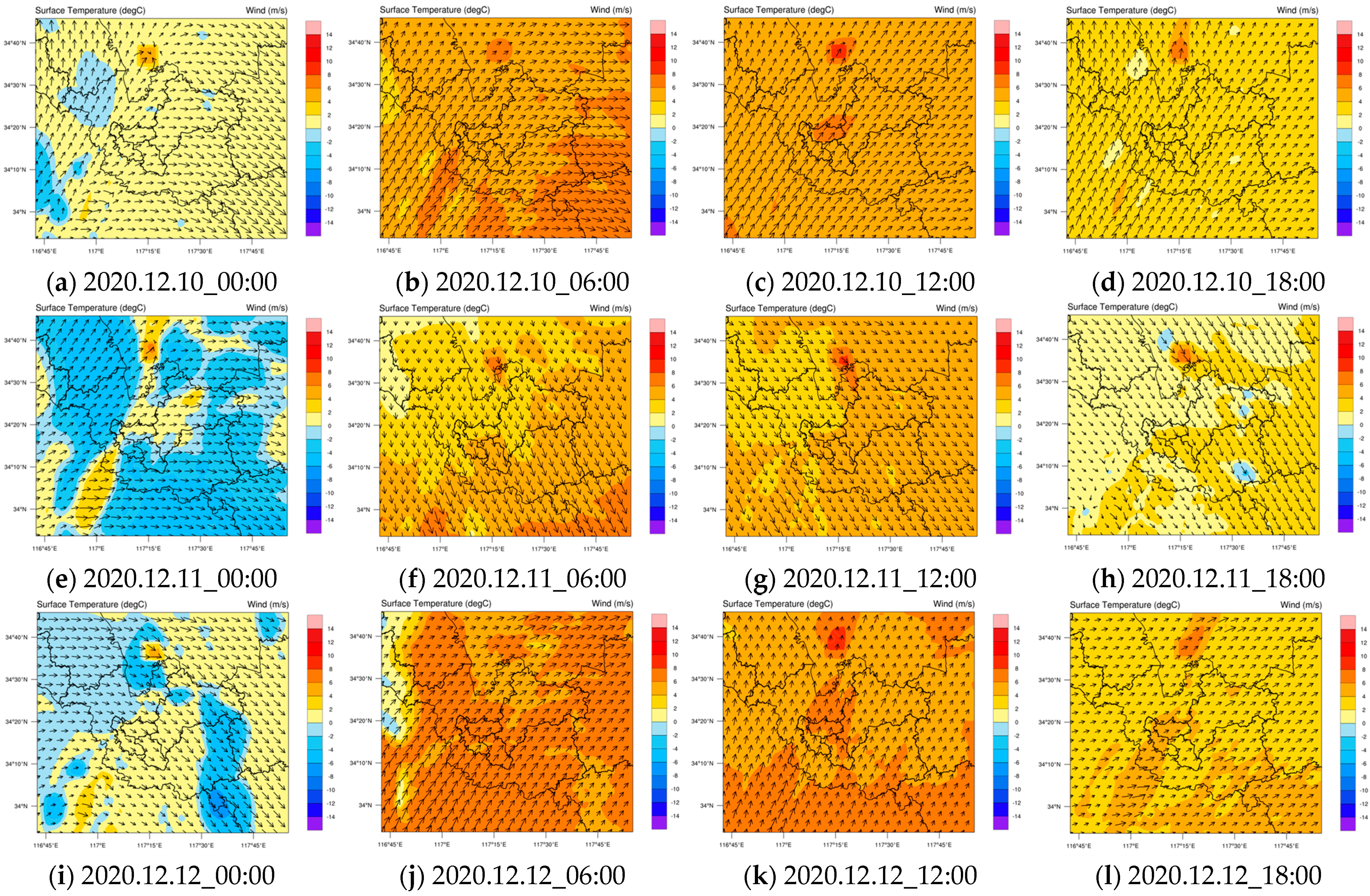



| Parameter | Scheme |
| Microphysical process | Lin scheme [42] |
| Cumulus parameterization | Grell3 scheme [43] |
| Long-wave radiation | RRTM scheme [44] |
| Short-wave radiation | Goddard scheme [45] |
| Surface layer | MM5 scheme [46] |
| Land surface | Noah scheme [47] |
| Boundary layer | YSU scheme [48] |
| Meteorochemical mechanism | CBMZ scheme [32] |
| Aerosol parameterization scheme | MOSAIC-4bins scheme [40] |
| Photochemical scheme | Fast-J scheme [49] |
| Concentration Limits for Pollutant Items (μg/m3) | ||||||||||
|---|---|---|---|---|---|---|---|---|---|---|
| IAQI | SO2 24 h Average | SO2 1 h Average | NO2 24 h Average | NO2 1 h Average | PM10 24 h Average | CO 24 h Average | CO 1 h Average | O3 1 h Average | O3 8-h Sliding Average | PM2.5 24 h Average |
| 0 | 0 | 0 | 0 | 0 | 0 | 0 | 0 | 0 | 0 | 0 |
| 50 | 50 | 150 | 40 | 100 | 50 | 2 | 5 | 160 | 100 | 35 |
| 100 | 150 | 500 | 80 | 200 | 150 | 4 | 10 | 200 | 160 | 75 |
| 150 | 475 | 650 | 180 | 700 | 250 | 14 | 35 | 300 | 215 | 115 |
| 200 | 800 | 800 | 280 | 1200 | 350 | 24 | 60 | 400 | 265 | 150 |
| 300 | 1600 | 565 | 2340 | 420 | 36 | 90 | 800 | 800 | 250 | |
| 400 | 2100 | 750 | 3090 | 500 | 48 | 120 | 1000 | 350 | ||
| 500 | 2620 | 940 | 3840 | 600 | 60 | 150 | 1200 | 500 | ||
| Variable | Air | Observed Mean (μg/m3) | Simulated Mean (μg/m3) | MB (μg/m3) | NMB (%) | NME (%) | RMSE | R |
|---|---|---|---|---|---|---|---|---|
| PM10 | All | 94.69 | 90.06 | −4.63 | −4.89 | 42.42 | 39.99 | 0.60 |
| PM2.5 | All | 91.52 | 87.41 | −4.10 | −4.48 | 41.93 | 39.23 | 0.63 |
| PM2.5 | Clean | 78.99 | 80.66 | 1.67 | 2.11 | 42.57 | 32.18 | 0.66 |
| PM2.5 | Polluted | 182.70 | 137.38 | −23.3 | −18.16 | 39.72 | 68.54 | 0.42 |
| Variable | Sample Number | Observed Mean | Simulated Mean | MB | NMB (%) | NME (%) | RMSE | R |
|---|---|---|---|---|---|---|---|---|
| WS (m/s) | 176 | 1.73 | 2.07 | 0.34 | 19.71 | 40.37 | 0.94 | 0.75 |
| T (℃) | 233 | 2.55 | 1.21 | −1.35 | −52.73 | 86.22 | 2.58 | 0.89 |
| RH (%) | 233 | 60.53 | 59.15 | −1.38 | −2.29 | 20.06 | 15.63 | 0.71 |
| P (hPa) | 233 | 1029.82 | 1028.95 | −0.87 | −0.08 | 0.09 | 1.16 | 0.99 |
Disclaimer/Publisher’s Note: The statements, opinions and data contained in all publications are solely those of the individual author(s) and contributor(s) and not of MDPI and/or the editor(s). MDPI and/or the editor(s) disclaim responsibility for any injury to people or property resulting from any ideas, methods, instructions or products referred to in the content. |
© 2024 by the authors. Licensee MDPI, Basel, Switzerland. This article is an open access article distributed under the terms and conditions of the Creative Commons Attribution (CC BY) license (https://creativecommons.org/licenses/by/4.0/).
Share and Cite
Liu, W.; Ling, X.; Xue, Y.; Wu, S.; Gao, J.; Zhao, L.; He, B. Study on the Concentration of Top Air Pollutants in Xuzhou City in Winter 2020 Based on the WRF-Chem and ADMS-Urban Models. Atmosphere 2024, 15, 129. https://doi.org/10.3390/atmos15010129
Liu W, Ling X, Xue Y, Wu S, Gao J, Zhao L, He B. Study on the Concentration of Top Air Pollutants in Xuzhou City in Winter 2020 Based on the WRF-Chem and ADMS-Urban Models. Atmosphere. 2024; 15(1):129. https://doi.org/10.3390/atmos15010129
Chicago/Turabian StyleLiu, Wenhao, Xiaolu Ling, Yong Xue, Shuhui Wu, Jian Gao, Liang Zhao, and Botao He. 2024. "Study on the Concentration of Top Air Pollutants in Xuzhou City in Winter 2020 Based on the WRF-Chem and ADMS-Urban Models" Atmosphere 15, no. 1: 129. https://doi.org/10.3390/atmos15010129
APA StyleLiu, W., Ling, X., Xue, Y., Wu, S., Gao, J., Zhao, L., & He, B. (2024). Study on the Concentration of Top Air Pollutants in Xuzhou City in Winter 2020 Based on the WRF-Chem and ADMS-Urban Models. Atmosphere, 15(1), 129. https://doi.org/10.3390/atmos15010129







